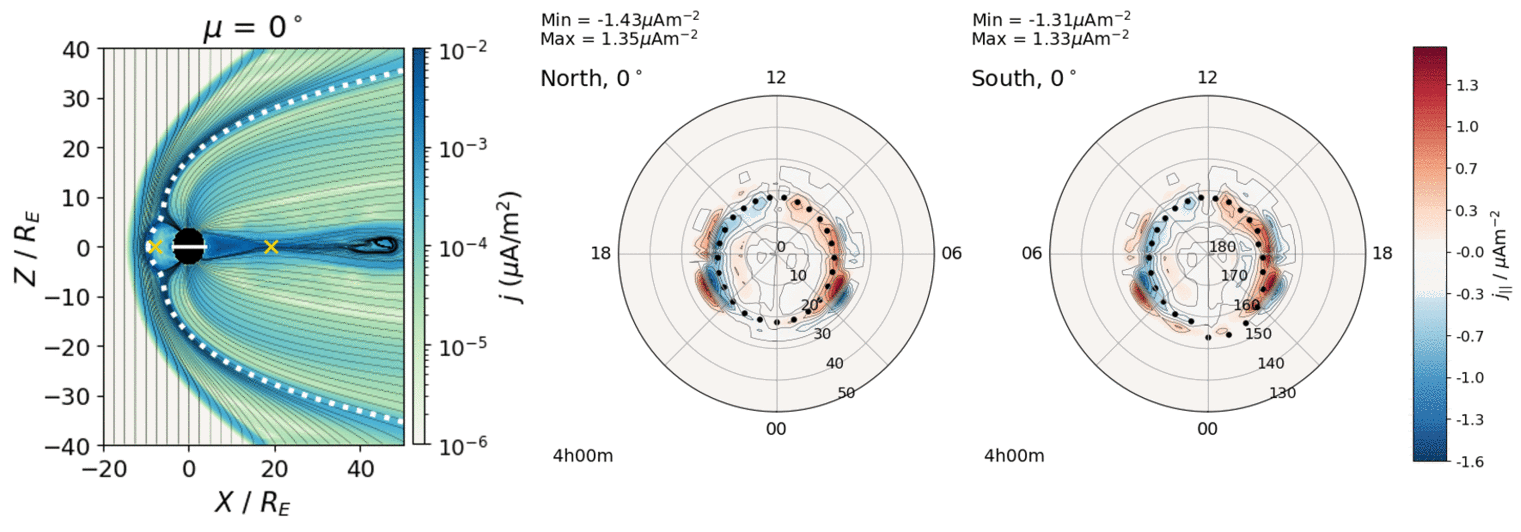MIST
Magnetosphere, Ionosphere and Solar-Terrestrial
Dipole Tilt Effect on Magnetopause Reconnection and the Steady‐State Magnetosphere‐Ionosphere System: Global MHD Simulations
By Joseph Eggington (Imperial College London)
The Earth's dipole axis is tilted with respect to the Sun; the extent of this tilt, given by the ‘dipole tilt angle’, changes both diurnally and seasonally as the planet orbits and rotates. This introduces numerous variabilities in the coupled magnetosphere‐ionosphere system, such as altering the location and intensity of magnetic reconnection, allowing the tilt angle to strongly influence magnetospheric convection. In this study, we perform global magnetohydrodynamic (MHD) simulations of the steady‐state magnetosphere‐ionosphere system using the Gorgon MHD code. We drive the system with purely southward Interplanetary Magnetic Field (IMF) conditions for tilt angles from 0–90°, exploring hypothetical configurations beyond the actual extreme of ~30° to elucidate the underlying tilt angle dependence of the system. We identify the location of the magnetic separator (the 3-D reconnection X-line) with increasing tilt angle, showing how the shift of the separator southward on the magnetopause and the resulting changes in the reconnection rate lead to weaker and more time-dependent coupling with the solar wind at large tilt angles.
These trends map down to the ionosphere, with the polar cap contracting as the tilt angle increases, and the region I field‐aligned current (FAC) system migrating to higher latitudes with changing morphology. As shown in the Figure, the hinging of the magnetotail current sheet towards the equator in a tilted configuration results in a longer convection pathway for open field lines in the Northern hemisphere, as the reconnection site on the nightside is shifted more weakly than on the dayside. This introduces a North‐South asymmetry in magnetospheric convection, driving more FAC in the Northern ionosphere for large tilt angles than in the South independent of hemispheric differences in conductance. These results highlight the strong sensitivity to onset time in the potential impact of a severe space weather event, since the intensity of stormtime FACs at a given location on the ionosphere will depend closely on the orientation of the dipole axis.

Figure: Animation of the effect of a changing dipole tilt angle on the magnetosphere-ionosphere system. The left panel shows a contour map of the magnetospheric current density in the noon-midnight meridian plane, with magnetic field lines in black. The orange crosses mark the approximate location of the dayside and nightside reconnection sites; the white dashed line shows the magnetopause location, and the solid white line represents the magnetic equator. The two right panels show contours of the FAC in the northern and southern ionosphere, with the open-closed boundary as a black dotted line.
Please see the paper for full details:
Eggington, J. W. B., Eastwood, J. P., Mejnertsen, L., Desai, R. T., & Chittenden, J. P. (2020). Dipole tilt effect on magnetopause reconnection and the steady‐state magnetosphere‐ionosphere system: Global MHD simulations. Journal of Geophysical Research: Space Physics, 125, e2019JA027510. https://doi.org/10.1029/2019JA027510